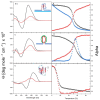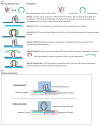Higher-Order DNA Secondary Structures and Their Transformations: The Hidden Complexities of Tetrad and Quadruplex DNA Structures, Complexes, and Modulatory Interactions Induced by Strand Invasion Events
- PMID: 39766239
- PMCID: PMC11673204
- DOI: 10.3390/biom14121532
Higher-Order DNA Secondary Structures and Their Transformations: The Hidden Complexities of Tetrad and Quadruplex DNA Structures, Complexes, and Modulatory Interactions Induced by Strand Invasion Events
Abstract
We demonstrate that a short oligonucleotide complementary to a G-quadruplex domain can invade this iconic, noncanonical DNA secondary structure in ways that profoundly influence the properties and differential occupancies of the resulting DNA polymorphic products. Our spectroscopic mapping of the conformational space of the associated reactants and products, both before and after strand invasion, yield unanticipated outcomes which reveal several overarching features. First, strand invasion induces the disruption of DNA secondary structural elements in both the invading strand (which can assume an iDNA tetrad structure) and the invaded species (a G-quadruplex). The resultant cascade of coupled alterations represents a potential pathway for the controlled unfolding of kinetically trapped DNA states, a feature that may be characteristic of biological regulatory mechanisms. Furthermore, the addition of selectively designed, exogenous invading oligonucleotides can enable the manipulation of noncanonical DNA conformations for biomedical applications. Secondly, our results highlight the importance of metastability, including the interplay between slower and faster kinetic processes in determining preferentially populated DNA states. Collectively, our data reveal the importance of sample history in defining state populations, which, in turn, determine preferred pathways for further folding steps, irrespective of the position of the thermodynamic equilibrium. Finally, our spectroscopic data reveal the impact of topological constraints on the differential stabilities of base-paired domains. We discuss how our collective observations yield insights into the coupled and uncoupled cascade of strand-invasion-induced transformations between noncanonical DNA forms, potentially as components of molecular wiring diagrams that regulate biological processes.
Keywords: DNA self-regulation pathways; DNA strand invasion; G-quadruplex/iDNA/duplex interconversions; competing kinetic and thermodynamic states; coupled transformations of higher-order DNA states; metastable DNA states; rough energy landscapes.
Conflict of interest statement
The authors declare no conflicts of interest. The funders had no role in the design of the study; in the collection, analyses, or interpretation of data; in the writing of the manuscript; or in the decision to publish the results.
Figures




























Similar articles
-
Determining the folding and unfolding rate constants of nucleic acids by biosensor. Application to telomere G-quadruplex.J Am Chem Soc. 2004 Oct 20;126(41):13255-64. doi: 10.1021/ja048398c. J Am Chem Soc. 2004. PMID: 15479079
-
Volumetric Interplay between the Conformational States Adopted by Guanine-Rich DNA from the c-MYC Promoter.J Phys Chem B. 2021 Jul 15;125(27):7406-7416. doi: 10.1021/acs.jpcb.1c04075. Epub 2021 Jun 29. J Phys Chem B. 2021. PMID: 34185535
-
Circular dichroism and guanine quadruplexes.Methods. 2012 May;57(1):64-75. doi: 10.1016/j.ymeth.2012.03.011. Epub 2012 Mar 17. Methods. 2012. PMID: 22450044 Review.
-
Role of locked nucleic acid modified complementary strand in quadruplex/Watson-Crick duplex equilibrium.J Phys Chem B. 2007 Oct 25;111(42):12328-37. doi: 10.1021/jp072705u. Epub 2007 Oct 3. J Phys Chem B. 2007. PMID: 17914789
-
Thermodynamic and kinetic characterization of the dissociation and assembly of quadruplex nucleic acids.Biopolymers. 2000-2001;56(3):147-94. doi: 10.1002/1097-0282(2000/2001)56:3<147::AID-BIP10011>3.0.CO;2-N. Biopolymers. 2000. PMID: 11745110 Review.
Cited by
-
Recent Progress in DNA Biosensors: Target-Specific and Structure-Guided Signal Amplification.Biosensors (Basel). 2025 Jul 23;15(8):476. doi: 10.3390/bios15080476. Biosensors (Basel). 2025. PMID: 40862937 Free PMC article. Review.
-
Conformational Propensities of a DNA Hairpin with a Stem Sequence from the c-MYC Promoter.Biomolecules. 2025 Mar 26;15(4):483. doi: 10.3390/biom15040483. Biomolecules. 2025. PMID: 40305258 Free PMC article.
References
-
- Wales D.J. Energy Landscapes Applications to Clusters, Biomolecules and Glasses. University of Cambridge; Cambridge, UK: 2004.
MeSH terms
Substances
Grants and funding
LinkOut - more resources
Full Text Sources

